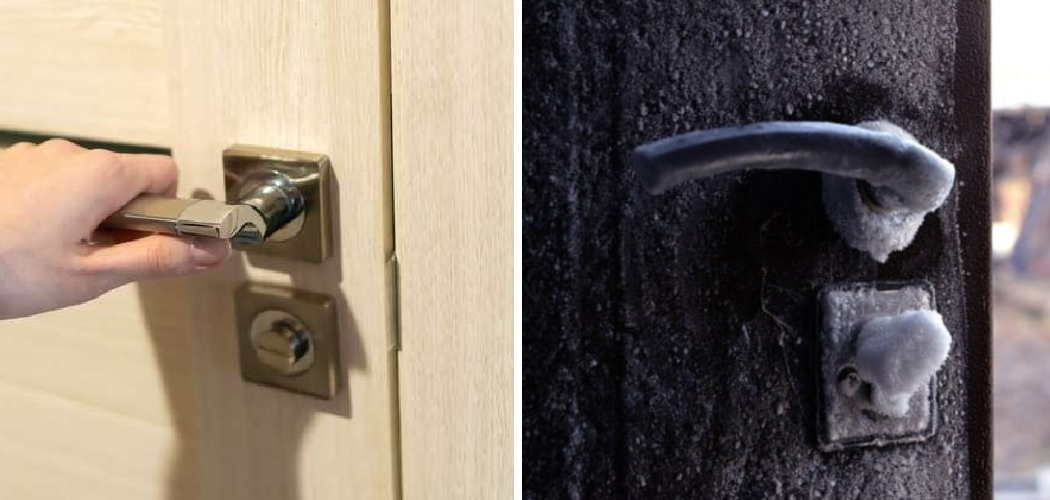Have you ever been in a situation where you’re standing outside your front door, heart racing as you fumble around for your keys, only to find the lock won’t open? Are you locked out of your house because the door lock is frozen? It is one of those moments when all else fails, and panic sets in.
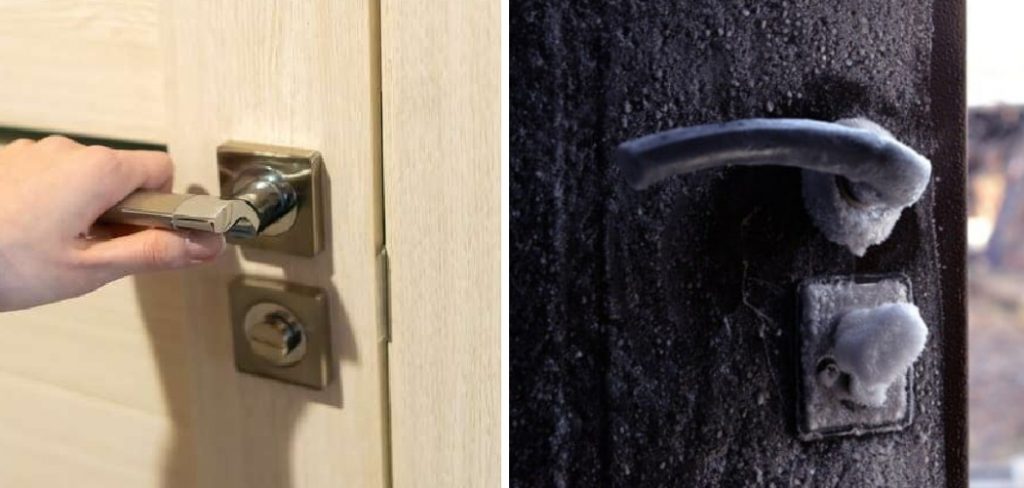
It’s a common problem that can be remedied with simple steps. With winter weather in full force, this issue can be frustrating and inconvenient, but there are easy solutions to help get you back inside. Relatively unskilled homeowners can fix their frozen locks with just a few simple steps and a bit of patience! In this blog post, we’ll look at how to unfreeze a house door lock quickly so you can keep warm and comfortable in no time!
Necessary Items
Before starting the process of unfreezing your door lock, make sure you have the following items:
- A hairdryer.
- Can of compressed air.
- Lubrication sprays such as WD-40.
These supplies will help you get back inside quickly and safely!
10 Steps on How to Unfreeze a House Door Lock
Step 1: Use A Hair Dryer
The first step in unfreezing a house door lock is to use a hair dryer. A hairdryer will help to remove moisture from the lockset and warm the metal, allowing you to turn the key and unlock the door.
Step 2: Use Compressed Air
Compressed air can blow away ice or moisture if a hair dryer doesn’t work. Ensure the lock is completely dried out before opening it with a key. Compressed

Step 3: Heat The Lock With a Water Bottle
If you don’t have access to a hairdryer or compressed air, use a warm water bottle to heat the lock. Fill a bottle with hot (not boiling) water and direct it at the lock until it melts away the ice blocking the keyhole.
Step 4: Use Lubricant
Once the ice has melted, lubricate the lock using WD-40 or another lubricant spray. This will help to keep the lock from freezing again in cold weather.
Step 5: Wiggle The Key
Once you’ve heated and lubricated the lock, it’s time to try opening it with your key. Gently wiggle the key as you insert it into the lock and turn it clockwise.
Step 6: Tap And Twist The Key
If the key isn’t turning, try tapping it with a hammer or another object and twisting it at the same time. This can help to loosen any residue that may be blocking the tumblers inside the lock.
Step 7: Use a Lock Pick
If the key still doesn’t turn, you can use a lock pick to open the door. These simple tools are relatively inexpensive and easy to use but require some skill and practice. If you don’t feel comfortable using a lock pick, it’s best to contact a locksmith for help.
Step 8: Drill Out the Lock
If all else fails, you may need to drill out the lock. This is a last resort option and should only be done by experienced professionals. Drilling out locks can cause permanent damage, so it’s best to contact a qualified locksmith before doing this step.
Step 9: Replace The Lock
Once you’ve unlocked the door, it’s important to replace the lock. Old and frozen locks are more prone to breaking, so it’s best to invest in a new one that won’t freeze or jam.
Step 10: Take Preventative Measures
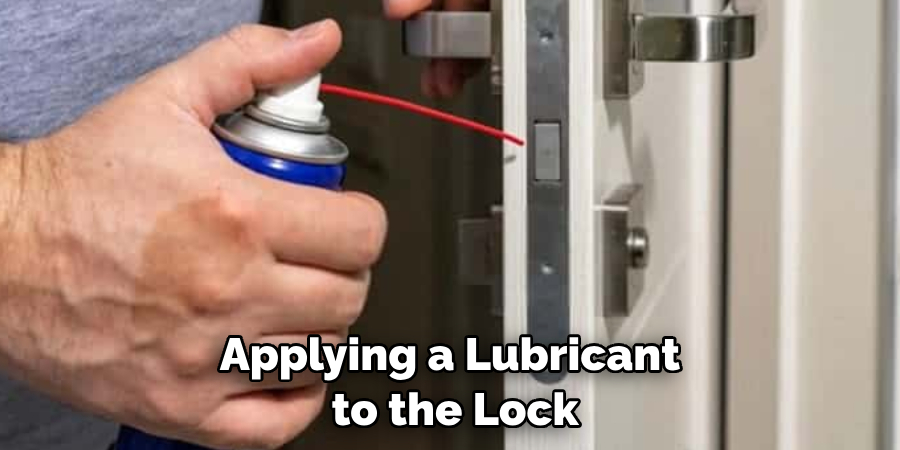
The last step is to take preventative measures to make sure this issue doesn’t happen again. Applying a lubricant to the lock before winter sets in can help keep moisture away and make sure your door opens properly when you need it to. You can also wrap insulation around the lock for extra protection from cold weather.
Frozen locks can be a hassle, but with the right steps, you can easily unfreeze your house door lock and be on your way. Keep these steps handy, just in case you ever find yourself locked out due to a frozen lock! Good luck, and stay warm this winter!
8 Things You Need to Know
1. Ensuring the Necessary Items
A hairdryer, a can of compressed air, and lubrication sprays such as WD-40 might be all the things you will need to use.
2. Use a Hair Dryer
A hairdryer is the first step to use in order to unfreeze your house door lock. It helps remove moisture from the lockset and warm up the metal so that you can turn the key and unlock the door.
3. Blow Away with Compressed Air
After using a hair dryer to no effect, you may want to use a can of compressed air in order to blow away any ice or moisture that might be blocking the keyhole.
4. Warm Up with Hot Water
If you don’t have access to a hair dryer or compressed air, why not try using a hot water bottle? Fill up a bottle with hot (not boiling) water and direct it at the lock until it melts away the ice blocking the keyhole.
5. Lubrication Sprays to Keep the Lock From Freezing Again
Once you’ve melt away the ice, use lubrication sprays such as WD-40 in order to keep the lock from freezing again due to cold weather.
6. Gently Wiggle the Key
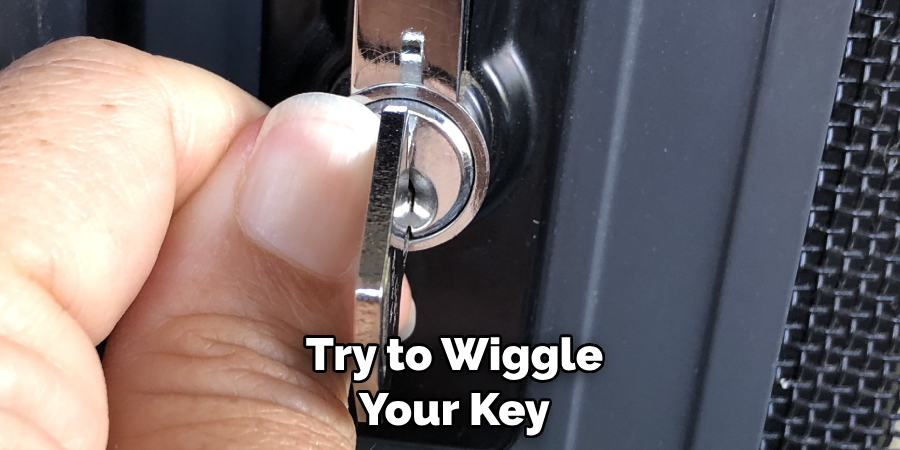
Once you’ve heated and lubricated the lock, gently try to wiggle your key as you insert it into the lock and turn it clockwise. This should open up the door if all goes well.
7. Tap & Twist
If the key isn’t turning, tapping it with a hammer or another object and twisting it at the same time can help to loosen any residue that may be blocking the lock.
8. Drilling Out the Lock
If all else fails, you may need to drill out the lock. This should only be done by experienced professionals, as doing so can cause permanent damage. Contact a qualified locksmith before taking this step, and remember: it is always best to replace your old lock with a new one that won’t freeze or jam!
Taking preventative measures to ensure your lock doesn’t freeze next winter can also be a smart move. Applying lubricant before the cold weather sets in and wrapping insulation around the lock are some of the things you could do for extra protection from cold weather. If you follow these tips, you can reduce the chances of being locked out due to a frozen lock!
Frequently Asked Questions
How Do You Unfreeze a Lock With Hand Sanitizer?
You can unfreeze a lock with hand sanitizer by applying it directly to the keyhole and inserting it. The alcohol in hand sanitizer helps to melt away ice or moisture, blocking the keyhole and allowing you to open the door. It is important to note that this should not be used as a long-term solution, as it could damage your door lock over time.
How Do You Unfreeze a Lock With Alcohol?
You can unfreeze a lock with alcohol by applying it directly to the keyhole and inserting it. The alcohol helps to melt away ice or moisture, blocking the keyhole and allowing you to open the door. It is important to note that this should not be used as a long-term solution, as it could damage your door lock over time. It is best to use lubrication sprays such as WD-40 or a hot water bottle for more permanent solutions.
What is the Best Way to Unfreeze a House Door Lock?
The best way to unfreeze a house door lock is to use a hairdryer, compressed air, or warm water bottle. If these methods don’t work, you can try using a lock pick or drilling out the lock with the help of a professional locksmith.
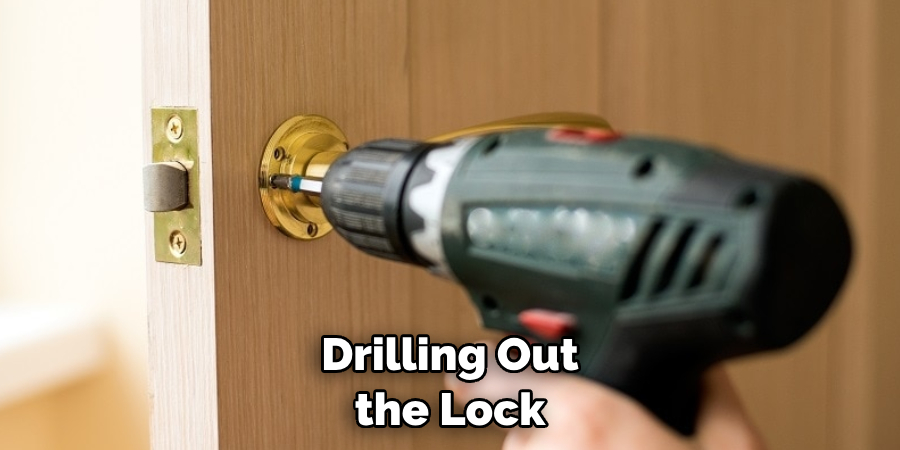
What Can I Do to Keep My Lock From Freezing Again?
Lubricating the lock with WD-40 or another lubricant spray can help keep it from freezing again in cold weather. You can also wrap insulation around the lock or apply some lubricant before winter sets in for extra protection.
How Much Damage Can Drilling Out a Lock
Drilling out a lock should only be done by experienced professionals, as it can cause permanent damage. It is best to contact a qualified locksmith before taking this step so you can prevent any unnecessary damage.
What Else Can I Do Besides Replacing the Lock?
You should take the necessary steps to ensure that your lock doesn’t freeze again in cold weather. Applying a lubricant to the lock before winter sets in can help keep moisture away and ensure your door opens properly when needed. You can also wrap insulation around the lock for extra protection from cold weather. Following these steps will significantly reduce the chances of being locked out due to a frozen lock!
Conclusion
Unfreezing a house door lock doesn’t have to be a difficult task. With the right steps and tools, and knowledge on how to unfreeze a house door lock, you can easily unlock your door without too much hassle. Remember to replace the lock after unlocking it, as old and frozen locks are more prone to breaking.
To help keep your lock from freezing again in cold weather, lubricate the lock with WD-40 or wrap insulation around it before winter sets in for extra protection. Taking these steps will significantly reduce the chances of being locked out due to a frozen lock! So ensure you keep all these tips handy when winter arrives, just in case you ever find yourself locked out due to a frozen lock!

